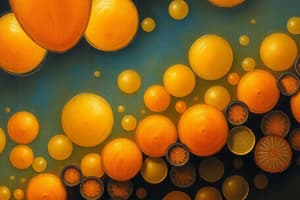Podcast
Questions and Answers
What is the main function of proteins in buffering?
What is the main function of proteins in buffering?
- Providing structural support to cells
- Transporting oxygen molecules
- Facilitating nutrient absorption
- Balancing pH changes in the body (correct)
Which of the following correctly describes a dipeptide?
Which of the following correctly describes a dipeptide?
- A molecule consisting of two amino acids (correct)
- A molecule consisting of four amino acids
- A molecule consisting of one amino acid
- A molecule consisting of three amino acids
Which type of proteins serve a role in defense against diseases?
Which type of proteins serve a role in defense against diseases?
- Enzymes
- Antibodies (correct)
- Hormonal proteins
- Transport proteins
What is a characteristic of a typical protein in terms of amino acid composition?
What is a characteristic of a typical protein in terms of amino acid composition?
What binds amino acids together in a protein structure?
What binds amino acids together in a protein structure?
What is the primary structural component found in biological membranes?
What is the primary structural component found in biological membranes?
Which of the following best describes the properties of phospholipids?
Which of the following best describes the properties of phospholipids?
What substance is often derived from cholesterol?
What substance is often derived from cholesterol?
How many fatty acid chains do phospholipids possess?
How many fatty acid chains do phospholipids possess?
Which of the following is a characteristic of liposomes?
Which of the following is a characteristic of liposomes?
What is the composition of proteins in terms of elemental makeup?
What is the composition of proteins in terms of elemental makeup?
What aspect of proteins contributes to muscle contraction?
What aspect of proteins contributes to muscle contraction?
What are the building blocks of proteins?
What are the building blocks of proteins?
Flashcards
Protein Functions
Protein Functions
Proteins have many crucial roles in the body, including transporting substances, maintaining pH balance, speeding up reactions, coordinating processes, and protecting against disease.
Amino Acids
Amino Acids
The building blocks of proteins. A central carbon atom linked to hydrogen, an amino group, a carboxyl group, and a variable side chain.
Peptide Bond
Peptide Bond
The chemical link that joins amino acids together to form a protein chain.
Polypeptide Chain
Polypeptide Chain
Signup and view all the flashcards
Protein Structure
Protein Structure
Signup and view all the flashcards
Phospholipid structure
Phospholipid structure
Signup and view all the flashcards
Amphipathic nature of phospholipids
Amphipathic nature of phospholipids
Signup and view all the flashcards
Phospholipid bilayer
Phospholipid bilayer
Signup and view all the flashcards
Liposome
Liposome
Signup and view all the flashcards
Steroids
Steroids
Signup and view all the flashcards
Cholesterol
Cholesterol
Signup and view all the flashcards
Amino Acid (AA)
Amino Acid (AA)
Signup and view all the flashcards
Study Notes
Cell and Tissue Biology (Lecture 2, Part A)
- Lecture covers biological membranes and extracellular matrix (ECM)
- Contents: Explores fats (lipids), molecules in the natural world (proteins, amino acids, DNA), biological membranes, ECM, and cell adhesion.
- Phospholipids: Essential components of cell membranes.
- Similar to triglycerides
- Formed by condensation reactions
- Contain only two fatty acid chains.
- A "head" group substitutes the third fatty acid, containing phosphorus and nitrogen
- Polar head (hydrophilic): Attracted to water
- Non-polar tail (hydrophobic): Repelled by water
- Phospholipid structure: The phospholipid molecule has a polar head and non-polar tail
- This structural feature results in an amphipathic nature of the molecule meaning it has both hydrophilic and hydrophobic properties
- Amphipathic nature: The combined hydrophobic and hydrophilic properties enable phospholipids (and other lipids) to organize into membranes. These properties ensure the phospholipids arrange so that the polar heads face the water (water-soluble) and the non-polar tails face away from water (water-insoluble).
- Phospholipid bilayer: A fundamental structure of cell membranes.
- Forms a bilayer with hydrophilic heads facing the aqueous environments (inside and outside of the cell) and hydrophobic tails facing each other in the middle.
- Phospholipid structures: Under certain conditions, phospholipids can form various structures.
- Micelles: Single phospholipid layer, typically formed in solution
- Liposomes: Double phospholipid layer forming a closed sphere. Often used for drug delivery.
- Steroids: Large lipid molecules containing four interconnected carbon rings.
- Cholesterol: The best-known steroid, found in all cell membranes
- Cholesterol plays a role in regulating membrane fluidity and is a precursor to some steroid hormones (sex hormones).
- Sources of cholesterol include diet and the liver can synthesize large amounts
- Fatty Acids: Essential components of lipids.
- Provide energy and structural support in the body
- Essential for cellular function
- Amino Acids and Proteins: Proteins are a vital part of the human body.
- Consists of a central carbon atom (C) bonded to an amino group, a carboxyl group, a hydrogen atom, and an R-group or side chain.
- Make up about 20% of the human body's weight.
- Composed of amino acids
- Functions: Support, movement, transport. buffering. metabolic regulation, coordination and control, defense.
- Protein Structure:
- Proteins are long chains of amino acids (AA)
- AA are joined together by peptide bonds to form polypeptide chains
- 20 different types of AA
- Individual AA differing in R-group/side chain
- Chains form various configurations, determining function.
- Globular proteins (such as hemoglobin and myoglobin have specific roles)
- Fibrous proteins (such as keratin have structural roles)
Studying That Suits You
Use AI to generate personalized quizzes and flashcards to suit your learning preferences.




